

JSI 2012 - Paris. Update 04 April: Registration Update 26 March: Draft programme Update 28 November: Hotel booking Update 21 November: downloads.
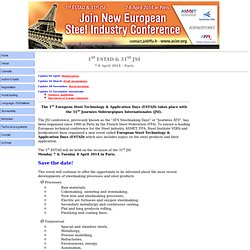
AHSS-Fig2-40. Blog Archive » Vanadium: A Strengthening Alloy Charged With Potential (US) (Credit Photo @ Seeking Alpha) Vanadium is a grey transition metal that is currently used as a strengthener in steel alloys.

Surging growth in the global steel industries will keep conventional demand for vanadium strong, but new upcoming applications for the metal, such as vanadium-redux batteries and lithium-ion batteries, is where the real potential for growth lies. Demand for vanadium is expected to more than double from current levels by the year 2025, according to TTP Squared Inc. We try to cover the context of a commodity, in this case vanadium, and we encourage investors to do their own due diligence on companies in this space. That said, we do have some recommendations on where to start your research. If you are looking for safe play, Largo Resources (LGORF.PK) is where you should begin looking.
Blog Archive » A History of China’s Steel Industry (US) Automotive Engineering International Online: The Battle of the Metals.
Home / Eurofer - Eurofer. Newly defined "Best available techniques" for iron & steel and glass production - News & events - JRC. Best available techniques set the permit conditions for iron & steel industrial installations in the EU © stock.xchng (ElRincon.
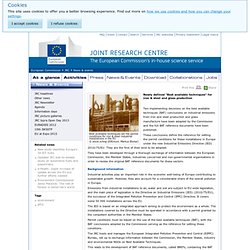
Markus Biehal) Two implementing decisions on the best available techniques (BAT) conclusions on industrial emissions from iron and steel production and glass manufacture have been adopted by the Commission and the full BAT reference documents have been published. These conclusions define the reference for setting the permit conditions for these installations in Europe under the new Industrial Emissions Directive (IED) 2010/75/EU.
They are the first of their kind to be adopted. They have been developed through a thorough exchange of information between the European Commission, the Member States, industries concerned and non-governmental organisations in order to review the original BAT reference documents for these sectors. Industrial activities play an important role in the economic well-being of Europe contributing to sustainable growth. Frame sites sidérurgiques. Les sociétés françaises productrices d'aciers spéciaux. Les aciers spéciaux. SPAS - La Chambre Syndicale des Producteurs d'Aciers Fins et Spéciaux. Developments in Steelmaking Capacity of Non-OECD Economies.
Silicon Steel for Laminations. OTUA. Ferroalloys. Offshore steel. The requirements on structural steel plates for offshore structures differ because of the varying fields of application and location.
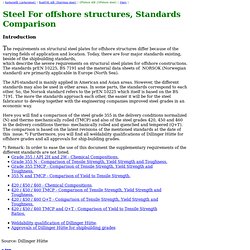
Today, there are four major standards existing, beside of the shipbuilding standards, which describe the severe requirements on structural steel plates for offshore constructions. The standards prEN 10225, BS 7191 and the material data sheets of NORSOK (Norwegian standard) are primarily applicable in Europe (North Sea). The API-standard is mainly applied in American and Asian areas.
However, the different standards may also be used in other areas. In some parts, the standards correspond to each other. "Il y a plus de 40 sortes d'aciers différents dans une voiture"- Chat Arcelor. Octobre 2006 Jean-Louis Pierquin : Bonjour, je suis ravi de pouvoir répondre à vos questions sur l'acier, sa fabrication, ses innovations.
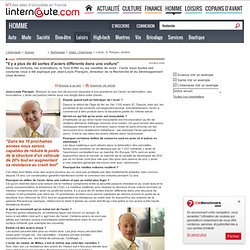
Boron in Steel: Part Two. Boron in steel as an alloying element Boron is useful as an alloying element in many materials, but here it will be illustrated as an alloying element in the steel because of its effect on hardenability enhancement.

Boron is added to unalloyed and low alloyed steels to enhance the hardness level through enhancement hardenability. Boron added to high-speed-cut steels, for example, containing 18%W, 4%Cr and 1%V, enhances their cutting performance, but reduces their forging qualities. Addition of boron in a quantity of up to 0.01% to austenitic steels also improves their high-temperature strength. High Strengths Steels: TRIP Steels.
TRIP-aided multiphase steels are a new generation of low-alloy steels that exhibit an enhanced combination of strength and ductility, thus satisfying the requirements of automotive industry for good formable high-strength steels.
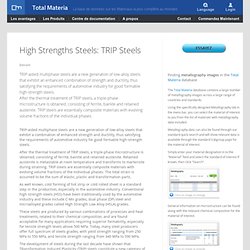
After the thermal treatment of TRIP steels, a triple-phase microstructure is obtained, consisting of ferrite, bainite and retained austenite. TRIP steels are essentially composite materials with evolving volume fractions of the individual phases. TRIP-aided multiphase steels are a new generation of low-alloy steels that exhibit a combination of enhanced strength and ductility, thus satisfying the requirements of automotive industry for good formable high-strength steels.
After the thermal treatment of TRIP steels, a triple-phase microstructure is obtained, consisting of ferrite, bainite and retained austenite. Glossaire de technologie automobile. World Steel Association - Home. Tata Steel in the automotive industry. Acier. Un article de Wikipédia, l'encyclopédie libre.
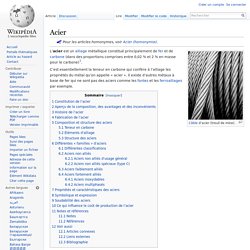
Câble d’acier (treuil de mine). L'acier est un alliage métallique constitué principalement de fer et de carbone (dans des proportions comprises entre 0,02 % et 2 % en masse pour le carbone)[1]. Constitution de l’acier[modifier | modifier le code] L’acier est élaboré pour résister à des sollicitations mécaniques ou chimiques ou une combinaison des deux. Pour résister à ces sollicitations, des éléments chimiques peuvent être ajoutés à sa composition en plus du carbone. Steel grades. Steel grades to classify various steels by their composition and physical properties have been developed by a number of standards organizations.

European standard steel grades[edit] EN 10027-1 steel grade designation system. [1] European standard steel grade names fall into two categories: Steel specified by purpose of use and mechanical properties.Steel specified by chemical composition. Superalloy. Nickel superalloy jet engine (RB199) turbine blade Examples of superalloys are Hastelloy, Inconel (e.g.
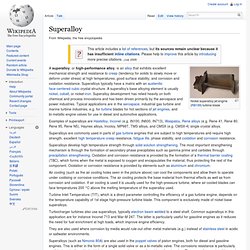
IN100, IN600, IN713), Waspaloy, Rene alloys (e.g. Rene 41, Rene 80, Rene 95, Rene N5), Haynes alloys, Incoloy, MP98T, TMS alloys, and CMSX (e.g. CMSX-4) single crystal alloys. Superalloys develop high temperature strength through solid solution strengthening. Stainless steel. In metallurgy, stainless steel, also known as inox steel or inox from French "inoxydable", is a steel alloy with a minimum of 10.5%[1] chromium content by mass.
Stainless steel does not readily corrode, rust or stain with water as ordinary steel does, but despite the name it is not fully stain-proof, most notably under low-oxygen, high-salinity, or poor-circulation environments.[2] There are different grades and surface finishes of stainless steel to suit the environment the alloy must endure. High-strength low-alloy steel. Copper, silicon, nickel, chromium, and phosphorus are added to increase corrosion resistance. Classification des aciers. Harry Brearley découvre l'acier inoxydable en 1912 en voulant stopper les phénomènes d'érosion d'un canon de fusil. En 1913, il fabrique un acier avec 12 % de chrome et le teste en utilisant des agents attaquants comme l'acide nitrique, le vinaigre et des aliments acides concluant que l'acier résistait à ces attaques.
Mais c'est son successeur, le Dr W. Hatfield qui, en 1924, inventa l'acier inoxydable 18/8 le mélange le plus connu. La première application remarquable dans la construction remonte à 1929 avec la couverture et la flèche du Chrysler Building. Acier rapide. Un article de Wikipédia, l'encyclopédie libre.
L’appellation acier rapide (AR), ou ARS pour « acier rapide supérieur », désigne les aciers outils ayant la capacité de conserver leur trempe à haute température. Ils sont notamment employés pour la découpe à haute vitesse (foret, …), d'où le terme « rapide », que l'on retrouve dans la désignation en anglais : high speed steel, abrégé HSS. Histoire[modifier | modifier le code] La production des premiers aciers rapides modernes commence aux États-Unis en 1910 (acier T1 -norme AISI-).
Ces aciers se caractérisaient par une teneur importante en tungstène. Aciers à outils. Un article de Wikipédia, l'encyclopédie libre. Ces aciers se caractérisent par de bonnes propriétés mécaniques générales à des duretés élevées (HRC supérieur à 55). On distingue les aciers de travail à froid (travail à température ambiante), les aciers de travail à chaud (travail à températures élevée), les aciers rapides (conçus pour les applications à haute température notamment la découpe à haute vitesse —forets, etc. — d'où la désignation) ou les aciers résistant aux chocs (burins de marteau-piqueur, etc.)
Pour atteindre les dureté nécessaires, il faut nécessairement des aciers trempés. Ils ont donc une forte teneur en carbone. Parmi les nuances couramment utilisées, citons : EN 45WCrV7 (1.2542), AISI S1 ;EN 100MnCrW4 (1.2510), AISI O1 ;EN X38CrMoV5 (1.2316), NF Z 38 CDV 5 ;EN X38CrMoV5-3 (1.2367), NF Z 38 CDV 5-3 ;EN X38CrMo16 (1.2316) ;EN X40CrMoV5-1 (1.2343), AISI H11 ou H13EN X100CrMoV5 (1.2363), NF Z 100 CDV 5, AISI A2 ;EN X153CrMoV12 (1.2379), NF Z 160 CDV 12, AISI D2 ; SAE steel grades. SAE International, as a standards organization, maintains several alloy numbering systems, one of which, for steel grades, is the SAE steel grades system.
In the 1930s and 1940s the American Iron and Steel Institute (AISI) and SAE were both involved in efforts to standardize such a numbering system for steels. These efforts were similar and overlapped significantly. Fabrication de l'acier. Un article de Wikipédia, l'encyclopédie libre. L'acier s'élabore actuellement de deux manières : Filières d'élaboration de l'acier Métallurgie primaire[modifier | modifier le code] Usine d'agglomération[modifier | modifier le code] Le minerai de fer possède des propriétés chimiques et physiques incompatibles qui le rendent inexploitable en l'état par le haut fourneau.
Les minerais sont préparés par broyage et calibration en grains qui s'agglomèrent entre eux. Fluage. Un article de Wikipédia, l'encyclopédie libre. Le fluage est le phénomène physique qui provoque la déformation irréversible différée (c'est-à-dire non-instantanée) d’un matériau soumis à une contrainte constante (notée ), inférieure à la limite d'élasticité du matériau, pendant une durée suffisante. Frittage. Un article de Wikipédia, l'encyclopédie libre. Ne doit pas être confondu avec frettage. Au XXIe siècle, le frittage est utilisé pour obtenir la densification de matériaux céramiques : Home - SMR. Galvanisation. Un article de Wikipédia, l'encyclopédie libre. La galvanisation est l'action de recouvrir une pièce d'une couche de zinc dans le but de la protéger contre la corrosion.
Le traitement est dit anti-corrosif. Trempe. Austénite. Un article de Wikipédia, l'encyclopédie libre. L'austénite est une solution solide de carbone dans l'allotrope γ du fer, qui est stable entre 911°C et 1 392°C. Cet allotrope a une structure cristallographique cubique à faces centrées, notation Strukturbericht A1, qui permet une grande solubilité du carbone (jusque 2,1 % massique à 1 147°C). Martensite. Un article de Wikipédia, l'encyclopédie libre. Ne pas confondre avec la martinsite synonyme de halite La martensite (fer α') est une phase métastable des aciers, issue de la transformation sans diffusion de l'austénite γ en dessous d'une température martensitique. Elle tire son nom de Adolf Martens (1850-1914) métallurgiste allemand. La structure de la martensite des aciers trempés est étudiée par Floris Osmond en 1890. La martensite cristallise selon un modèle quadratique hybride. Cubique à faces centrées.
Un article de Wikipédia, l'encyclopédie libre. Cubique centré. Physical Metallurgy of Iron and Steel.